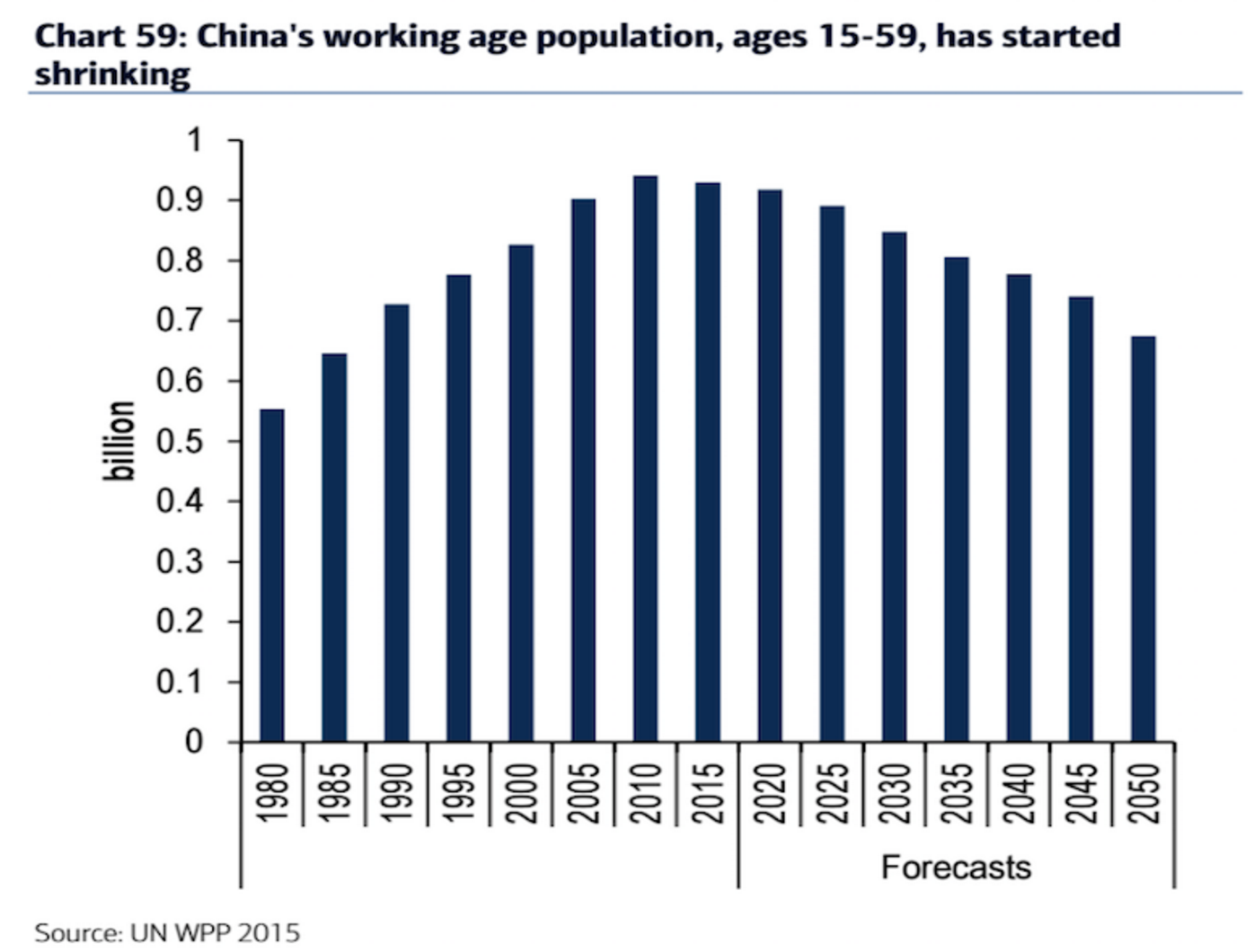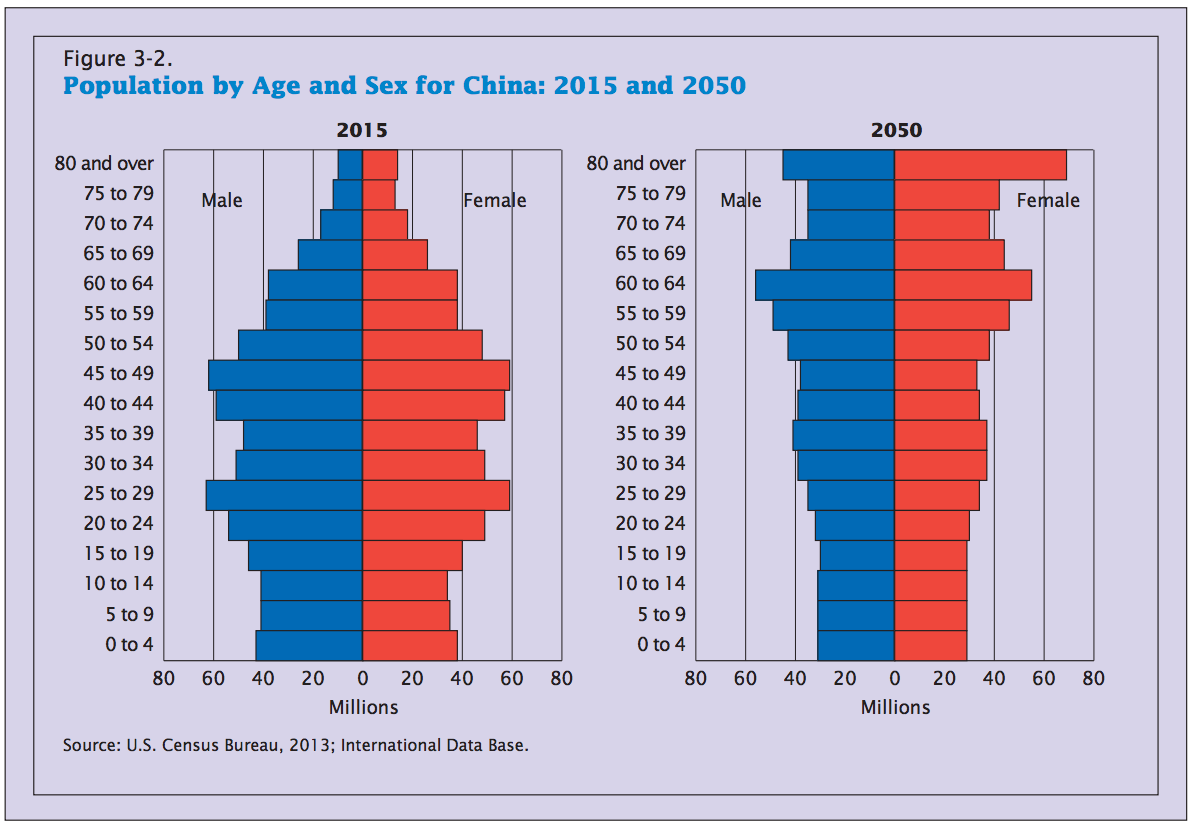It’s no secret that many countries face looming demographics problems as their populations age.
Much has been written about developed markets like Japan, Germany, and Italy, which have the largest percentages of their populations age 65 and up.
But another country also deserves attention: China.
In a recent note to clients, a Bank of America Merrill Lynch team led by Beijia Ma shared a chart showing that China’s working-age population — aka people 15 to 59 — has already started shrinking and is set to continue to decline.
The BAML team wrote in the note:
“For China to rise to be the world’s #2 economy, the country saw its working-age population expand by 380mn people between 1980 and 2015. During this time, millions of people from rural China migrated to cities for urban manufacturing jobs. While this has pushed China to be the world’s largest manufacturing economy in 2010, it is expected to peak in 2017.”
But “by 2050, the size of China’s population will decline by around 60mn, while the working-
age population will decline by 212mn or around 1/3. This is the size of the current population of Brazil, the world’s 5th most population nation,” they noted.
This is particularly startling given that China’s also going to have a huge over-65 population in the near future — meaning that it will see the same kinds of problems as aging developed markets like Japan.
In March, a report on the global-aging phenomenon from the US Census Bureau illustrated some comparisons between China’s over-65 population and the total population of several big developed markets:
- In 2015, the number of older people in China (136.9 million) exceeded Japan’s total population (126.9 million).
- By 2030, Japan and Egypt’s combined total projected populations (231.8 million) will be smaller than China’s projected 65-and-up population (238.8 million).
- And by 2050, China’s projected older population (348.8 million) will be approximately equal to the combined total projected populations of Japan, Egypt, Germany, and Australia.
The Census Bureau report also included population pyramids, which illustrate the sex and age breakdown of a country’s population, for China in 2015 and 2050. The most striking thing in the charts is the huge growth in the over-65 category, which you can see below:
Another thing that stands out is the relatively small population of younger people, which is partially because of the one-child policy introduced in the late 1970s. And even though the government recently retired it, the impact from that won’t be seen for some time.
Putting this all together, in the coming decades there will be far more older residents who will likely want to retire and fewer working-age citizens to support them, assuming that the projections hold.
Historically, aging populations have generally been a problem that more developed markets like Japan have had to deal with, rather than emerging economies like China, as we have noted before. So, the graying of China could present new problems and opportunities that we haven’t seen in other markets before.




 Japan reports fewer children and more elderly people for 35th year in a row
Japan reports fewer children and more elderly people for 35th year in a row 16 facts about China that will blow your mind
16 facts about China that will blow your mind Japanese government to give all 18-and-under residents 100,000 yen… here’s why that’s bad news
Japanese government to give all 18-and-under residents 100,000 yen… here’s why that’s bad news Nintendo DS on the menu as Japanese prisons get creative to keep ageing prisoners’ brains active
Nintendo DS on the menu as Japanese prisons get creative to keep ageing prisoners’ brains active 16 facts about India that will blow your mind
16 facts about India that will blow your mind McDonald’s new Happy Meals offer up cute and practical Sanrio lifestyle goods
McDonald’s new Happy Meals offer up cute and practical Sanrio lifestyle goods More foreign tourists than ever before in history visited Japan last month
More foreign tourists than ever before in history visited Japan last month Arrest proves a common Japanese saying about apologies and police
Arrest proves a common Japanese saying about apologies and police The oldest tunnel in Japan is believed to be haunted, and strange things happen when we go there
The oldest tunnel in Japan is believed to be haunted, and strange things happen when we go there Is the new Shinkansen Train Desk ticket worth it?
Is the new Shinkansen Train Desk ticket worth it? Starbucks reopens at Shibuya Scramble Crossing with new look and design concept
Starbucks reopens at Shibuya Scramble Crossing with new look and design concept Our reporter takes her 71-year-old mother to a visual kei concert for the first time
Our reporter takes her 71-year-old mother to a visual kei concert for the first time Tokyo’s most famous arcade announces price increase, fans don’t seem to mind at all
Tokyo’s most famous arcade announces price increase, fans don’t seem to mind at all Randomly running into a great sushi lunch like this is one of the best things about eating in Tokyo
Randomly running into a great sushi lunch like this is one of the best things about eating in Tokyo Amazing exhibition of Japan’s legendary “cursed katana” is going on right now【Photos】
Amazing exhibition of Japan’s legendary “cursed katana” is going on right now【Photos】 Disney princesses get official manga makeovers for Manga Princess Cafe opening in Tokyo
Disney princesses get official manga makeovers for Manga Princess Cafe opening in Tokyo We try out “Chan Ramen”, an underground type of ramen popular in the ramen community
We try out “Chan Ramen”, an underground type of ramen popular in the ramen community Foreign English teachers in Japan pick their favorite Japanese-language phrases【Survey】
Foreign English teachers in Japan pick their favorite Japanese-language phrases【Survey】 Beautiful new Final Fantasy T-shirt collection on the way from Uniqlo【Photos】
Beautiful new Final Fantasy T-shirt collection on the way from Uniqlo【Photos】 There’s a park inside Japan where you can also see Japan inside the park
There’s a park inside Japan where you can also see Japan inside the park New Studio Ghibli bedding sets are cool in all senses of the word
New Studio Ghibli bedding sets are cool in all senses of the word Japanese convenience store packs a whole bento into an onigiri rice ball
Japanese convenience store packs a whole bento into an onigiri rice ball Hanton rice — a delicious regional food even most Japanese people don’t know about, but more should
Hanton rice — a delicious regional food even most Japanese people don’t know about, but more should New Pokémon cakes let you eat your way through Pikachu and all the Eevee evolutions
New Pokémon cakes let you eat your way through Pikachu and all the Eevee evolutions Hamburg and Hamburg Shibuya: A Japanese restaurant you need to put on your Tokyo itinerary
Hamburg and Hamburg Shibuya: A Japanese restaurant you need to put on your Tokyo itinerary Studio Ghibli releases Kiki’s Delivery Service chocolate cake pouches in Japan
Studio Ghibli releases Kiki’s Delivery Service chocolate cake pouches in Japan Japan’s bone-breaking and record-breaking roller coaster is permanently shutting down
Japan’s bone-breaking and record-breaking roller coaster is permanently shutting down New definition of “Japanese whiskey” goes into effect to prevent fakes from fooling overseas buyers
New definition of “Japanese whiskey” goes into effect to prevent fakes from fooling overseas buyers Foreign passenger shoves conductor on one of the last full runs for Japan’s Thunderbird train
Foreign passenger shoves conductor on one of the last full runs for Japan’s Thunderbird train Our Japanese reporter visits Costco in the U.S., finds super American and very Japanese things
Our Japanese reporter visits Costco in the U.S., finds super American and very Japanese things Kyoto bans tourists from geisha alleys in Gion, with fines for those who don’t follow rules
Kyoto bans tourists from geisha alleys in Gion, with fines for those who don’t follow rules Studio Ghibli unveils Mother’s Day gift set that captures the love in My Neighbour Totoro
Studio Ghibli unveils Mother’s Day gift set that captures the love in My Neighbour Totoro Domino’s Japan now sells…pizza ears?
Domino’s Japan now sells…pizza ears? New Japanese KitKat flavour stars Sanrio characters, including Hello Kitty
New Japanese KitKat flavour stars Sanrio characters, including Hello Kitty Kyoto creates new for-tourist buses to address overtourism with higher prices, faster rides
Kyoto creates new for-tourist buses to address overtourism with higher prices, faster rides Sales of Japan’s most convenient train ticket/shopping payment cards suspended indefinitely
Sales of Japan’s most convenient train ticket/shopping payment cards suspended indefinitely Sold-out Studio Ghibli desktop humidifiers are back so Totoro can help you through the dry season
Sold-out Studio Ghibli desktop humidifiers are back so Totoro can help you through the dry season Japanese government to make first change to romanization spelling rules since the 1950s
Japanese government to make first change to romanization spelling rules since the 1950s Ghibli founders Toshio Suzuki and Hayao Miyazaki contribute to Japanese whisky Totoro label design
Ghibli founders Toshio Suzuki and Hayao Miyazaki contribute to Japanese whisky Totoro label design Doraemon found buried at sea as scene from 1993 anime becomes real life【Photos】
Doraemon found buried at sea as scene from 1993 anime becomes real life【Photos】 Tokyo’s most famous Starbucks is closed
Tokyo’s most famous Starbucks is closed One Piece characters’ nationalities revealed, but fans have mixed opinions
One Piece characters’ nationalities revealed, but fans have mixed opinions We asked a Uniqlo employee what four things we should buy and their suggestions didn’t disappoint
We asked a Uniqlo employee what four things we should buy and their suggestions didn’t disappoint Princesses, fruits, and blacksmiths: Study reveals the 30 most unusual family names in Japan
Princesses, fruits, and blacksmiths: Study reveals the 30 most unusual family names in Japan Studio Ghibli’s new desktop Howl’s Moving Castle will take your stationery on an adventure
Studio Ghibli’s new desktop Howl’s Moving Castle will take your stationery on an adventure Online “Population Decrease Map” of Japan paints a bleak, womanless future for the country
Online “Population Decrease Map” of Japan paints a bleak, womanless future for the country Japan’s ‘agri-tech’ farming revolution
Japan’s ‘agri-tech’ farming revolution Shanghai Disneyland to feature Chinese elements and the largest castle ever, opens spring 2016
Shanghai Disneyland to feature Chinese elements and the largest castle ever, opens spring 2016 Guangdong would rank as the world’s 12th most populous nation, and other fun with China’s census
Guangdong would rank as the world’s 12th most populous nation, and other fun with China’s census Japan suffers 37th consecutive year of low birthrate, Japanese people may become extinct someday
Japan suffers 37th consecutive year of low birthrate, Japanese people may become extinct someday Abandoned Japanese houses transformed into stunning modern homes
Abandoned Japanese houses transformed into stunning modern homes 17 Mind-Blowing Facts About Russia
17 Mind-Blowing Facts About Russia World’s largest retail LEGO store to open just outside of Shanghai Disneyland Park in June
World’s largest retail LEGO store to open just outside of Shanghai Disneyland Park in June 9 futuristic jobs we could see by 2030
9 futuristic jobs we could see by 2030 8 ways Kim Jong-Un has blindsided the US
8 ways Kim Jong-Un has blindsided the US The number of elderly people in Japan this year has yet again smashed multiple records
The number of elderly people in Japan this year has yet again smashed multiple records The Tokyo area welcomed more new foreign residents than Japanese ones last year
The Tokyo area welcomed more new foreign residents than Japanese ones last year Bedridden Japanese elderly home residents transformed into stars of the silver screen
Bedridden Japanese elderly home residents transformed into stars of the silver screen Population aging in Japan gets a corona-boost as pregnancies drop by 11 percent this year
Population aging in Japan gets a corona-boost as pregnancies drop by 11 percent this year China’s Special Forces in Hong Kong go through a ridiculous training regimen
China’s Special Forces in Hong Kong go through a ridiculous training regimen
Leave a Reply